|
|
 |
|
Calanoida ( Order ) |
|
|
|
Arietelloidea ( Superfamily ) |
|
|
|
Heterorhabdidae ( Family ) |
|
|
|
Heterorhabdus ( Genus ) |
|
|
| |
Heterorhabdus subspinifrons Tanaka, 1964 (F,M) | |
| | | | | | | Syn.: | Heterorhabdus (Heterorhabdus) subspinifrons : Bradford-Grieve, 1999 b (p.88, figs.F,M, Rem., figs.175, 191) | | | | Ref.: | | | Tanaka, 1953 (p.134, nom. nud.); 1964 a (p.14, figs.F,M); Morris, 1970 (p.2301, 2314, figs.F); Chihara & Murano, 1997 (p.819, Pl.118,120: F,M); Park, 2000 (p.97, figs.F,M, Rem.) | 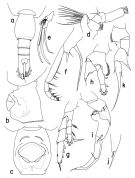 issued from : T. Park in Bull. Scripps Inst. Oceanogr. Univ. California, San Diego, 2000, 31. [p.216, Fig.64]. Female: a, urosome (dorsal); b, c, genital somite (left, ventral, respectively); d, left Mx1 (posterior); e, distal end of left Mx2 (posterior); f, right Mxp (anterior); g, P5 (anterior). Male: h, right P5 (distal exopodal segments omitted), anterior; i, right P5 (endopod omitted), posterior; j, distal end of exopod of right P5 (lateral); k, left P5 (endopod omitted), anterior.
|
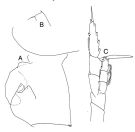 issued from : J.M. Bradford-Grieve in The Marine Fauna of New Zealand: Pelagic Calanoid Copepoda. National Institute of Water and Atmospheric Research (NIWA). NIWA Biodiversity Memoir, 111, 1999. [p.89, Fig.56]. Female: A, genital somite (left lateral side); B, forehead (left lateral side); C, P5.
|
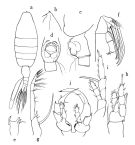 issued from : O. Tanaka in Publs Seto Mar. Biol. Lab., 1964, XII (1). [p.16, Fig.180]. As Heterorhabdus sub-spinifrons; Female: a, habitus (dorsal); b, forehead (left lateral side); c, last thoracic segment and genital somite (left lateral side); d, genital somite (ventral); e, masticatory edge of Md; f, Mx2; g, Mxp; h, P1; i, P5. Nota: The urosome segments and furca are in the proportional lengths as 40:16:12:12:20 (left ramus) = 100. A1 exceeds the end of the furca by distal 2 segments. Male: j, P5. Nota: The urosome segments and furca are in the proportional lengths as 22:18:15:12:9:24 = 100.
|
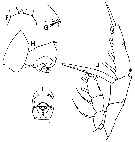 issued from : B. Morris in J. Fish. Res. Bd Canada, 1970, 27 (12). [p.2315, Fig.9, F-J]. Female (from off N Hawai): F-G, forehead (dorsal) and lateral, respectively); H, posterior prosome and genital segment (latezral); I, genital segment (ventral); J, right P5. Nota: This is the first report of this species outside its type locality of Sagami Bay (Japan). The specimen is larger than Tanaka's (1964) specimens and the inner marginal spine of the exopodite segment 2 of P5 is as long as the exopodite segment 3 of P5 rather than slightly shorter.
|
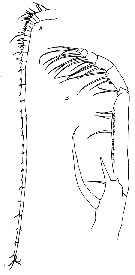 issued from : B. Morris in J. Fish. Res. Bd Canada, 1970, 27 (12). [p.2317, Fig.10, A, B]. Female: A, A1; B, Mxp.
|
 Heterorhabdus subspinifrons Heterorhabdus subspinifrons female: 1 - See key to species groups of Heterorhabdus: ''spinifrons'' Group (p.90, 91). 2 - Forehead with a spiniform process. 3 - Anterior wall of genital proninence with a pair of rounded lobes (Fig.64-b,c). 4 - Genital prominence reaching posterior end of somite. Endopod of Mx1 with 1 seta (Fig.64-d).
|
 Heterorhabdus subspinifrons Heterorhabdus subspinifrons male: 1 - See key to species groups of Heterorhabdus: ''spinifrons'' Group (p.90, 91). 2 - Forehead with a spiniform process. 3 - In right P5, basal inner lobe relatively long and somewhat fingerlike, medial projection of 2nd exopodal segment (Fig.64-i) with small terminal spiniform process and relatively well developed distal lobe. 4 - Basal inner lobe of right P5 (Fig.64-h) almost as long as segment, pointing straight distad. Endopod of Mx1 (Fig.64-d) with 1 seta.
| | | | | Compl. Ref.: | | | Dessier, 1983 (p.89, Tableau 1, Rem., %); Hsiao & al., 2004 (p.326, tab.1); Dur & al., 2007 (p.197, Table IV); Williamson & McGowan, 2010 (p.273, Table 3, Pacific central gyres: N and S); Hsiao S.H. & al., 2011 (p.475, Appendix I) | | | | NZ: | 7 | | |
|
Distribution map of Heterorhabdus subspinifrons by geographical zones
|
| | | | | |  Chart of 1996 Chart of 1996 | |
| | | | Loc: | | | S Atlant., S Indian, Malay Archipelago, China Seas (East China Sea, South China Sea), Taiwan (SW, E), Japan (Sagami Bay), Pacif. central (E-W), Pacific (central gyres: N and S), off N Hawaii, off California, off Chile, off NW New Zealand, N Tasman Sea
Type locality: Sagami Bay (Japan) | | | | N: | 9 | | | | Lg.: | | | (92) F: 2,7; (121) F: 2,27; M: 2,11; (824) F: 3,2-2,56; M: 3,16-2,6; (909) F: 2,4; 2,8; {F: 2,27-3,20; M: 2,11-2,60} | | | | Rem.: | "Spinifrons" Group.
Mesopelagic, epipelagic (at night in the Pacific tropical by Dessier, 1983).
For Tanaka (1964 a, p.17) tee species closely resembles H. spinifrons (Claus) but can be easily distinguished from it.
According to Morris (1970, p.2315) this species can be distinguished from H. spinifrons by the size, by having a pair of lamellar processes on the anterioventral surface of the genital segment, and by the proportional lengths of the segments of the A1 (see Tanaka, 1964). | | | Last update : 06/01/2015 | |
|
|
 Any use of this site for a publication will be mentioned with the following reference : Any use of this site for a publication will be mentioned with the following reference :
Razouls C., Desreumaux N., Kouwenberg J. and de Bovée F., 2005-2025. - Biodiversity of Marine Planktonic Copepods (morphology, geographical distribution and biological data). Sorbonne University, CNRS. Available at http://copepodes.obs-banyuls.fr/en [Accessed November 15, 2025] © copyright 2005-2025 Sorbonne University, CNRS
|
|
 |
 |








